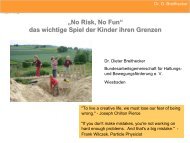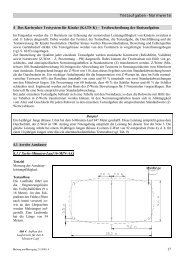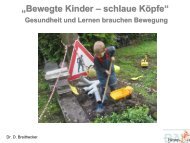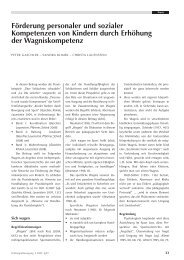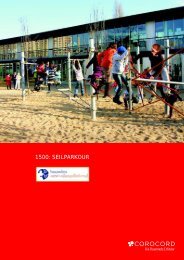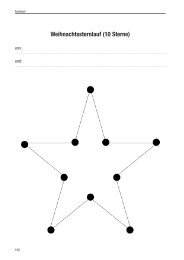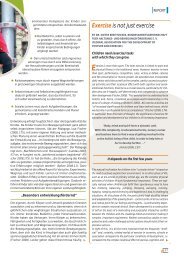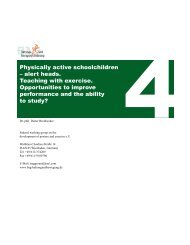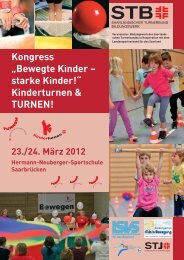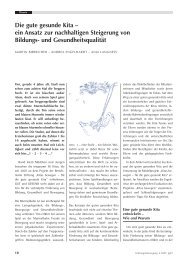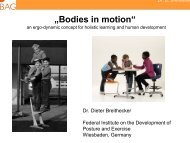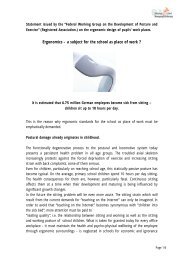45-055-84 - XXXXXX Sti - Bundesarbeitsgemeinschaft für Haltungs
45-055-84 - XXXXXX Sti - Bundesarbeitsgemeinschaft für Haltungs
45-055-84 - XXXXXX Sti - Bundesarbeitsgemeinschaft für Haltungs
You also want an ePaper? Increase the reach of your titles
YUMPU automatically turns print PDFs into web optimized ePapers that Google loves.
<strong>45</strong>-<strong>055</strong>-<strong>84</strong> - <strong>XXXXXX</strong> <strong>Sti</strong>
Enjoying school,<br />
Fun in learning.<br />
More health and well-being in the "school as place of work”.<br />
A project report.<br />
Dieter Breithecker<br />
2
Federal working group on the development of posture and exercise, registered association 2
Federal working group on the development of posture and exercise, registered association 3<br />
1. Problem definition<br />
At the time, back complaints represent the population’s illness<br />
No. 1. These complaints are the cause of medical and therapeutic<br />
costs in billions. The causes have been scientifically documented<br />
and manifest themselves mainly in an increasingly seated<br />
working population (Reinhardt 1991). The sitting place of<br />
work has also become typical for schoolchildren as well !<br />
It is a fact that due to the progressive development of computer<br />
technology and the growing mental demands as well as the<br />
trend towards increasing social isolation, the behavioral profile<br />
of children and youths has increasingly changed. Physical exercise<br />
and movement is being displaced more and more from<br />
daily life in favour of abstract and digitalized occupations -<br />
which are exclusively carried out in a sitting position.<br />
However, for children and youths the health consequences are<br />
particularly fatal. Continuous sitting affects them just at a time<br />
when the decisive, highly sensitive growth changes which are<br />
consequently particularly prone to improper strain are determining<br />
their maturity and development.<br />
Children are becoming increasingly physically inactive and<br />
are sitting more and more.<br />
The "German Federal Working Group on the Development of<br />
Posture and Exercise” (Registered Association) has already<br />
been occupied for several years with the observation of the relationships<br />
between the lack of exercise, increasing sitting habits<br />
and the lack of health and fitness in childhood and teenage (see<br />
Breithecker 1996, Breithecker 1998, Illi; Breithecker 1998) whereby<br />
in a highly developed country such as Germany the following<br />
facts have become the dominant risk factor of government<br />
health-politics:<br />
• Over 83% of primary school children sit at chair - desk combinations<br />
which are not suitable for their body height (dpa<br />
report from January 2002) !<br />
• On the average, children of primary school age spend 9 hours<br />
per day sitting (Bös 1999) !<br />
• One third of schoolchildren between the ages of 7 and 17<br />
years complain of the "school headache” (Illi 1991, Faustmann<br />
1994) !<br />
• Postural complaints at primary school age are increasing significantly<br />
(Berquet 1998 and Balaque 1988 amongst others) !<br />
• A lot of school furniture is out-of-date and does not conform<br />
to the minimum orthopaedic-physiological requirements in<br />
any way (Greithecker 1996, Jerosch, Jansen 1997) !<br />
Illustration 1: Encouragement of exercise in the school as place of work<br />
The sitting situation in German schools is miserable !<br />
Experts are unanimous that at the latest when reaching school<br />
age, a happily-moving playing child becomes a sitting child. In<br />
the future, the sitting problem will become more acute. The sitting<br />
strain which will result from the current demands for "teaching<br />
on the Internet” can only be imagined. In order to avoid<br />
that "teaching on the Internet” becomes synonymous with<br />
"children into the sickbay”, more attention must be paid to "seating<br />
quality”, i.e. the relationship between sitting and working<br />
as well as the sitting and working postures of schoolchildren.<br />
The school as an institution is regarded as a particularly important<br />
place for the first step in the development of health-relevant<br />
modes of behaviour. The school as a flexible system capable<br />
of adapting to social changes should therefore place great<br />
value on a classroom concept with a variety of resources enabling<br />
ergonomic-physiological working (see Illus. 1).<br />
2. The model school: a school in and with movement<br />
Resulting from this responsibility, a pilot project "the school as<br />
place of work ? what will the future classroom look like?”<br />
was started at the Fridtjof-Nansen school in Hannover as a<br />
four-year long-term study at the beginning of the 1999/2000<br />
school year. The Fridtjof-Nansen school with its pioneering<br />
school programme "motional school - school as learning system<br />
in the district” is particular suitable to handle this theme. For<br />
the last seven years in connection with the BLK pilot project<br />
"Network of health-promoting schools” , the school has been<br />
concerned with the formulation of health-relevant questions on<br />
the school as living area. Starting from the basic idea that a<br />
schoolchild’s place of work should comply with the specific<br />
requirements of the individual and his/her work in the same way<br />
as an industrial workplace must do, concrete concepts on the<br />
ergonomic arrangement of the "school as place of work” and<br />
movement in the classroom were worked-out in cooperation<br />
with the "German Federal Working Group on the<br />
Development of Posture and Exercise”. These are based on the<br />
ideas expressed in Illustration 1.<br />
Surroundings animate modes of behaviour<br />
Encouragement of exercise in the school as place of work<br />
The study will include concrete findings on the sitting and<br />
motional behaviour as well as the effect on the postural development<br />
of the children. Circumstances and behaviour<br />
influence are regarded as indispensable, cross-stimulating,<br />
lasting factors in this investigation approach.<br />
Work organisation Circumstantial influence<br />
Behavioural influence<br />
• Elimination of tie between work and place of work<br />
• Project work, small group work, independent work<br />
• Weekly planned work<br />
• Information stations<br />
• Child-friendly and movement-stimulating arrangement<br />
of place of work (table-chair-combination)<br />
and working surroundings, e.g. integration of<br />
stand-at lectern/desks, computer terminals as<br />
stand-at places of work, reclining surfaces<br />
• Good examples, information, encouragement and training<br />
on awareness of and behaviour needed for bodily health<br />
• Imparting of knowledge and experience about<br />
(sitting-) posture-physiological relationships<br />
• Motivation of lasting changes in behaviour
Federal working group on the development of posture and exercise, registered association 4<br />
3. Ergonomic demands and realization<br />
What is taken for granted today for every office place of work<br />
- it must provide the ergonomic surroundings for maintaining<br />
the health and psycho-physical wellbeing of the employee - is<br />
neglected in schools for economic reasons and ignorance.<br />
However, the school is a "place of work” not only for teachers<br />
but for the children as well. Both parents and teachers<br />
currently demand high performance from school children. It is<br />
therefore particularly necessary that this is achieved in ergonomic<br />
pupils’ places of work which satisfy the particular psychophysical<br />
requirements of growing children.<br />
In respect of the ergonomic arrangement of the place of work<br />
in the school, it is essential that both the school chair and the<br />
desk/table should be matched and regarded as an entity. They<br />
should assist the pupil in his/her work and not be a strain in any<br />
way. The basic prerequisite of an ideal schoolchild’s place of<br />
work are sitting and writing furniture which not only suit or<br />
can be adjusted to suit the size of the child but also their need<br />
for varying working postures ("dynamic sitting”) and thus contribute<br />
to physiologically correct sitting with movement. In<br />
addition, the table should be equipped with an inclinable top<br />
with a minimum inclination of 16°.<br />
The first four school years are equipped with ergonomic school<br />
furniture based on the above-mentioned principles which satisfy<br />
the physical-mental desire for movement and not confront<br />
the child with rigid designs. In particular, the following arrangements<br />
have been provided. Two differing ergonomic designs<br />
of chairs are available which are however each based on a<br />
movable seat support.<br />
One of these is the so-called "flexichair” which is not adjustable<br />
in height, the necessary selection of a suitable size being the<br />
responsibility of the teacher. In the case of the "flexichair”, the<br />
seat inclination changes from front to back in response to<br />
changes in position of the centre of gravity of the body weight,<br />
i.e. if a child adopts the front sitting posture, then the seat surface<br />
is inclined forwards and partially the opposite. (see illus. 2)<br />
The other chair version is a mobile swivel chair with "rocking<br />
mechanism” and stepless height adjustment. The "rocking<br />
mechanism” enables an approx. 7° inclination of the seat surface<br />
either forwards or backwards depending on whether the<br />
pupil sits on the front or rear third of the seating surface. (see<br />
illus. 3)<br />
Both types of chair make the physiologically valuable but accident<br />
prone "tilting” of the chair unnecessary. The movable seating<br />
surface resorbs but doesn’t block the natural and healthy<br />
need for movement.<br />
Illus. 2: Sitting still with pleasant relief on the "PantoSwing-LuPo” flexible<br />
chair.<br />
Illus. 3: Active sitting on the "PantoTurn”
Federal working group on the development of posture and exercise, registered association 5<br />
Illus. 4: More physical and mental mobility through the stand-at<br />
lectern/desk.<br />
A further important ergonomic addition to the test classrooms<br />
is a stand-at lectern which is steplessly adjustable in height and<br />
fitted with a large round working top. Because of space limitations,<br />
the teacher doesn’t have his own lectern. If necessary<br />
he/she lowers the stand-at lectern and sits at it otherwise this<br />
item of furniture is available for the schoolchildren particularly<br />
during group work or phases of individual work. (see illus. 4)<br />
A further reorganization of the classroom for space saving reasons<br />
is the provision of tall cupboards which make more floor<br />
space available for variations in the daily working routine (sitting<br />
in circles, group work, corner for reclining). In order to facilitate<br />
the regular rearrangement of the furniture, all heavy<br />
items found on the floor (sideboard, pupils’ desks) are fitted<br />
with castors.<br />
4. The test method(s)<br />
The project "the school as place of work ? what will the future<br />
classroom look like?” continues the work started in the last few<br />
years in the field of the "active school” (more movement in the<br />
school as living area). The specific investigation aims of this<br />
project are concentrated on preventive measures in the classroom<br />
- the possible health promotion of ergonomic and pedagogic<br />
sitting concepts - an area neglected up to now. The study<br />
is a long term one and intended to last four years (1st ? 4th<br />
school years). The four form Fridtjof-Nansen primary school has<br />
been chosen for this project because of its claim to be the<br />
"classroom of the future” on account of it having the ergonomic<br />
furnishings described.<br />
For comparison purposes, two forms of a neighbouring primary<br />
school have been selected. This school is fitted with conventional<br />
school furniture which is not regularly matched to the<br />
pupils’ growth and where there is no special teacher training in<br />
respect of ergonomic and physiological matters.<br />
The examination of the effectiveness of a classroom concept<br />
modified in line with ergonomic, pedagogic and active sitting<br />
considerations is restricted to the partial areas of posture and<br />
behaviour promotion or change. With the help of the following<br />
investigation methods, the positive effects of the modified<br />
classroom concept will be analyzed during and at the end of the<br />
study with repect to the future furnishing and arrangement of<br />
classrooms:<br />
• medical-orthopaedic examination<br />
• modified posture test (HAKI 6-10) for primary schoolchildren<br />
• observations of behaviour<br />
• issue of questionnaires<br />
The medical-orthopaedic as well as the sport motoric and<br />
physiological examination results will not be statistically evaluated<br />
and publicized before the end of the long-term study. From<br />
time to time during the course of the study which is intended<br />
to last four years, specific behaviour observations will be carried<br />
out and questionnaires issued with the intention of checking<br />
the effectiveness of the ergonomic classroom furnishings. The<br />
behaviour observations described below are intended to analyze<br />
the sitting and postural behaviour to be used in the first<br />
school year on the available conditions.<br />
5. Description and discussion of the behaviour observation.<br />
5.1 Details of the behaviour observation<br />
With the help of a selected group of schoolchildren in the first<br />
school year and using the behaviour observation described here,<br />
we attempt to verify the following hypothesis:<br />
A lasting effect on the body and movement behaviour and thus<br />
an oriented rhythmic change from static to dynamic, from tension<br />
to relief, from strain to relaxation for the psychomotoric<br />
needs of primary schoolchildren at the "school as place of work”<br />
can be achieved through the specific surroundings and behaviour<br />
as well as the working organizational arrangements described<br />
in Section 1.<br />
In each test and comparison classroom, three children were<br />
selected for the determination of body behaviour. Emphasis was<br />
placed on the fact that these three children had differing characteristic<br />
inclination to movement as chosen by their teacher.
Federal working group on the development of posture and exercise, registered association 6<br />
• a passive type (hereafter called type 0)<br />
• a normally active type (hereafter called type 1)<br />
• a restless type (hereafter called type 2)<br />
These totaled 12 schoolchildren in the four test classes and six<br />
in two selected comparison classes. Actual behaviour observations<br />
were started after an initial three school month start-up<br />
phase. The children in the test classes thus had adequate time<br />
to accustom themselves to the ergonomic conditions in the<br />
classroom; the teachers in the test classes had sufficient time<br />
to give the children basic information and instructions on<br />
physiological sitting and body behaviour. At the same time there<br />
was enough time to establish the three different behaviour characteristics.<br />
The observation situations were so organized that the corresponding<br />
teacher of the subject gave the lessons and always<br />
three observers (one for each of the three motor movement profiles)<br />
made notes. Each child was watched over 12 school hours.<br />
The observation periods were spread out over the school year,<br />
during different subjects and organizational forms during the<br />
morning. The observations thus included school lessons with<br />
more restricted work places (frontal teaching) as well as more<br />
unrestricted work places (project teaching, handicrafts).<br />
Prior to commencing their work, the observers were comprehensively<br />
instructed about the forms to be filled-in and the<br />
variables to be recorded. The instructions given to the observers<br />
were to follow the teaching carefully and the accurately record<br />
the corresponding actions of the pupils on the observation<br />
record form in the boxes which were designated in abbreviated<br />
form (e.g. R= reading, W= writing).<br />
5.2 Observation of the bodily behaviour of all schoolchildren<br />
under the aspect of " utilization of ergonomic resources”<br />
In this contribution, the analysis and interpretation of the<br />
observed bodily behaviour of all pupils will be compared. Here<br />
the prominent question is just how much the ergonomic classroom<br />
furnishings contributed to a bodily behaviour which included<br />
more movement and was thus more physiological. To enable<br />
the interested reader to better understand the physiological<br />
significance and thus the health-influencing value of a<br />
dynamic body/work relationship in interaction with the ergonomic<br />
surroundings, the individual discussion will be comprehensively<br />
explained in the course of the observation analysis.<br />
In connection with the analyses and interpretations, it must be<br />
stressed once more, that the teachers in the test classes have<br />
received a very convincing training in respect to the necessity<br />
of conditional and behaviour-preventative measures in schools<br />
and the children were comprehensively instructed in the use of<br />
the ergonomic furnishings. Of course, these important and<br />
essential training measures significantly influenced the modes<br />
of behaviour and will not always be emphasized in the following<br />
discourse.<br />
The observations of the body behaviour of all schoolchildren in<br />
the test and comparison classes showed that during the observation<br />
sessions, the body behaviour modes dominant in Illus. 5a<br />
and 5b were able to be recorded.<br />
11,4<br />
a. Test classes b. Comparison classes<br />
17,3<br />
71,3<br />
13,4<br />
Illus. 5a and 5b: Body behaviour in the test and comparison classes<br />
It is obvious, that the pure sitting times in the comparison classes<br />
are more significant time-wise than those in the test classes.<br />
The main reason for this is that in the test classrooms there<br />
was a stand-at lectern/table available. Added to the "not-sitting<br />
body positions” were such behaviour modes as standing for a<br />
short time at the place of work, moving around the room during<br />
changes to the working configuration (e.g. arranging a seating<br />
circle) but also lying for a short time on the mattress provided<br />
in the corner for this purpose. It is also recognizable here, that<br />
as a result of a greater (trained) tolerance for active body behaviour<br />
and the advantage to the children of the mobility of the<br />
facilities (easily moved on castors) which facilitates the frequent<br />
rearrangement of the working configuration, more dynamic<br />
in the teaching method is brought about.<br />
0<br />
86,6<br />
Sitting Standing at stand-at lectern/desk Non-sitting posture
Federal working group on the development of posture and exercise, registered association 7<br />
5.3 Observation of the sitting behaviour of all schoolchildren<br />
and its effect on psycho-physical development processes.<br />
The significant difference in the sitting times noticeable in the<br />
comparison of the different classes under examination has already<br />
been mentioned. Although the percentage of the time spent<br />
sitting in the test classes (71.3%) appears relatively high, it<br />
becomes relative however when one analyses the sitting behaviour.<br />
In accordance with the urge to be active which is necessary<br />
for their physical and mental development, the children<br />
have made their sitting behaviour not statically passive but<br />
dynamically active. This is shown by the continuous change<br />
between the front sitting position (34.4%), rear sitting position<br />
(29.4%), riding position (13.9%), side position (12.8%) and<br />
other positions (9.5%).<br />
a. Test classes b. Comparison classes<br />
34,4<br />
29,4<br />
13,9 12,8 9,5<br />
36,8<br />
48,1<br />
6,7 8,4<br />
front SH rear SH riding seat pos. side SH other SH<br />
Illus. 6: Dynamic sitting (SH = sitting position)<br />
In the test classes, the forward sitting position was used most.<br />
Is this also the active sitting position ? no contact to the bakkrest,<br />
back muscles activated - this well-known working position<br />
is principally adopted for writing and reading. In contrast,<br />
the rear sitting position, also known as the resting position, was<br />
mainly used for listening or dialogue purposes.<br />
The lighter and in some cases turnable ergonomic chairs with<br />
their intentionally narrower lower backrest section particularly<br />
encouraged the "riding position” sitting variation (see Illus. 7).<br />
Just like the side sitting position, these variations were most<br />
used in seating circles and group work. The healthy urge of the<br />
schoolchild for movement was also responsible for further short<br />
time sitting variations such as sitting on the knees, sitting with<br />
one leg alternatively underneath the bottom, sitting on the seat<br />
edge with one leg trailing backwards etc. All these alternative<br />
positions have been collected together under "other sitting<br />
positions”.<br />
Illus. 7: Riding seat position.<br />
The opposite was to be found in the comparison classes where<br />
the rear sitting position (rest position) with 48.1% is dominant.<br />
The main reason for this is the seating surface of traditional<br />
school furniture. The rigid surface inclined backwards positively<br />
encourages the user to position his body exclusively against the<br />
backrest. This static-passive body posture as well as the rightangled<br />
sitting position adopted on traditional chairs has dramatic<br />
long-term effects on the development of the maturing<br />
postural and locomotive system (see Breithecker 1998 on this<br />
subject). It was very difficult for the children in the comparison<br />
classes to adopt the "riding position” because the wide lower<br />
part of the backrest hardly permitted such an alternative sitting<br />
position.<br />
The "healthy urge for movement” of the children in the comparison<br />
classes made itself significantly less noticeable through<br />
the adoption of short-term changes of position such as "sitting<br />
sidewards” (6.7%) as well as "other sitting positions” (8.4%)<br />
where "tilting the chair” was used most.<br />
The observations confirmed what we had suspected. When<br />
appropriate seat versions which encourage dynamic sitting are<br />
available and the teacher not only allows but actively encourages<br />
a reasonable active-dynamic sitting behaviour, then the<br />
schoolchildren will make consequent use of it.<br />
It is only the regular dynamic change between static and dynamic,<br />
between strain and relief, that the whole body achieves its<br />
relaxation. "When this change of position even in the greatest<br />
relaxed position - i.e lying or sleeping soundly - is automatical
Federal working group on the development of posture and exercise, registered association 8<br />
ly carried-out by the human body anatomically and physiologically,<br />
how much more necessary must such a change be by the<br />
physiologically extremely unsuitable sitting position " (Hanel,<br />
Kempes, Vogel 1190, 20)!<br />
Dynamic sitting has important effects on postural physiological<br />
parameters.<br />
This active-dynamic sitting is a sitting with movement which<br />
regularly encourages the movement of the pelvis forwards, to<br />
the side and backwards. This mobility of the pelvis is accompanied<br />
by a redeposition of the sacrum and with its end plate on<br />
which the lowest disc and thus the spinal column sits. This<br />
means that each change of position of the pelvis is accompanied<br />
by an appropriate dynamic of the spinal column.<br />
Active-dynamic sitting means economy of effort ! So long<br />
as this active-dynamic equilibrium play can be kept up, then<br />
a natural physiological strain and relief of the muscles,<br />
sinews, ligaments, spinal discs and vertebrae involved in sitting<br />
is active.<br />
In addition, the intentional change of stress supports the<br />
demand for a muscle-controlled sitting ("sitting upright”)<br />
because in contrast to passive sitting on a comfortable chair,<br />
the long-term fitness of the muscles is increased. In the course<br />
of the change to different sitting positions, a group of muscle<br />
fibres is always needed for maintaining the position, the<br />
others have time to recover. The result is a symmetrical stress<br />
demand with agreed agonistical and antagonistical muscle<br />
balance. This continuously active muscle dynamic not only<br />
encourages continuous training of the spinal column muscles<br />
but stimulates the economical nourishment and waste disposal<br />
of this organ.<br />
Furthermore, dynamic sitting with movement supports the diffusion<br />
processes in the spinal discs as these are no longer exposed<br />
to a partial continuous pressure but are surface stressed, i.e.<br />
the distribution of the pressure takes place alternately over the<br />
whole surface. A regular change of sitting position can thus<br />
almost be regarded as a "diffusion pump”.<br />
Many of the sitting variations chosen by the children in the<br />
course of dynamic sitting, such as the riding position, the rear<br />
sitting position or the so-called "lolling position” actually represent<br />
relaxing positions. These are specific measures intended to<br />
achieve short-term relief of the body - in our case the spinal<br />
column. They are based, amongst others, on the physical fact<br />
that the centre of the trunk sits on the greatest possible supporting<br />
surface and must not do any holding work. Each enlargement<br />
of the supporting surface contributes to the relief of the<br />
body.<br />
Any exhortation to "sit still” or "stop wriggling” would just at<br />
this phase be contrary to the intrinsic needs of the child and<br />
cause long-term damage not only to the postural apparatus.<br />
Dynamic sitting has important influences on neurophysiological<br />
parameters.<br />
Static passive sitting can have a lasting effect on the schoolchild’s<br />
ability to concentrate because not only the childish muscles<br />
are unsuitable for continuous static stress but also the childish<br />
mind. It is well known that in the human organism there<br />
are a considerable number of control systems which are concerned<br />
with posture and movement. Without doubt, the most<br />
important control system is the neural and neuro-muscular<br />
system. Conventional sitting does not place sufficient demand<br />
on the neuro-muscular system and thus has a negative effect<br />
on the development of the active and passive postural and<br />
motional apparatus. Many different movements particularly<br />
during long and monotonous sitting periods by appropriate<br />
change of sitting position and the change from sitting to standing<br />
deliver the necessary neuro-physiological impulses "because<br />
it is through the control circuits that the reflexes are controlled<br />
and the reflex motor kept awake” (Reinhardt 1991 b,<br />
100)<br />
The healthy brain of a child unconsciously signals the need for<br />
a dynamic change of stress which makes itself noticeable as<br />
motoric restlessness, for example, by tipping the chair. This<br />
behaviour which is often falsely interpreted by teachers as<br />
disturbance of the teaching and is not entirely without danger<br />
(chair tipping over backwards) was almost completely absent<br />
with the chairs used in our tests. It should be well known by<br />
now that children are hardly able to sit still and concentrate<br />
over a lengthy period of time.<br />
Movement doesn’t only come from the head, it also uses the<br />
head<br />
An adequate level of psycho-mental activity is the prerequisite<br />
for attention and concentrated learning. Uniform requirements<br />
which are quite common in the case of static-passive frontal<br />
teaching encourage a condition of reduced psycho-mental activity<br />
with the result that the child gives up his psycho-physical<br />
posture (withdraws into him/herself, lack of concentration,<br />
vacant gaze with vagrant thoughts) or the organism looks for<br />
additional stimulation (compensating bodily activity). Motoric<br />
activity such as stretching or craning or tipping on the chair as<br />
compensating self-regulation to maintain psycho-mental activity<br />
is not, as is regularly assumed by teachers, to be lack of<br />
discipline or interest but rather an involuntary measure intended<br />
to prevent a disorganization of behaviour.
Federal working group on the development of posture and exercise, registered association 9<br />
Motoric activities, such as are realized here through dynamic<br />
sitting serve to maintain the conditions for attentive<br />
and concentrated behaviour. In this way the "monotony<br />
experienced when repeatedly carrying out a similar and<br />
unvarying activity” (Ulrich 1992, 282) can be mitigated<br />
when schoolchildren have the opportunity to arrange their<br />
sitting behaviour dynamically and if possible freely choose<br />
their own body and working posture.<br />
34,6<br />
24,9<br />
13,9 14,2 12,4<br />
front SH rear SH riding seat pos. side SH other SH<br />
Illus. 8: "Requirement-ergonomics” ? School furniture must suit the needs of<br />
the schoolchildren and not vice-versa. (SH = sitting position)<br />
6. Conclusions<br />
Today, significantly different requirements must be placed on<br />
the quality of seating and the flexible body and working postures<br />
associated dependent on it. Children are becoming increasingly<br />
inactive and spending<br />
considerable more time sitting. "Children are always children of<br />
their generation”. The children of the nineteen fifties and sixties<br />
used to play on the streets and thus had adequate opportunity<br />
and space for exercise. However the changes in society in the<br />
last few years and to be expected in the future have a more<br />
restrictive influence on the need for exercise of the adolescents.<br />
The increasing publication of a wide spectrum of psycho-physical<br />
disturbances at children’s age clearly states the necessity for<br />
preventative measures. A study from Prof. Bös from the<br />
University of Karlsruhe (1999) confirms what many suspected:<br />
Today, primary schoolchildren spend on the average nine hours<br />
(!) daily sitting in the school, at home doing homework, before<br />
the television and the computer.<br />
The demand for ergonomic school furniture and the dynamic<br />
body and working posture associated with it is, when<br />
considered from a health promoting viewpoint, not a<br />
question of comfort but a medical-health necessity.<br />
Address of the author:<br />
Dr. Dieter Breithecker<br />
<strong>Bundesarbeitsgemeinschaft</strong> <strong>für</strong> <strong>Haltungs</strong>- und<br />
Bewegungsförderung e.V.<br />
Friedrichstrasse 14<br />
D - 65185 Wiesbaden
Federal working group on the development of posture and exercise, registered association 10



